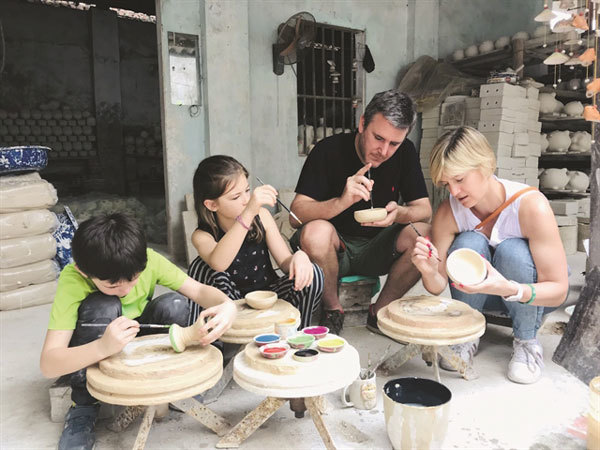 |
| Tourists love to discover the traditional culture and lifestyle of the local people. Photo courtesy of the Bat Trang Tourism Company |
When Bat Trang Commune on the outskirts of Hanoi was officially recognised as a tourist site last month, his traditional house with its beautiful garden, old kiln and showroom of pottery products started receiving many tourists every day.
Last month, the Hanoi People’s Committee and the Vietnam National Administration of Tourism (VNAT) brought smart tourism to Bat Trang, further highlighting it on the capital’s travel map.
Smart tourism
Bat Trang Commune is located in Gia Lam District, 10km from the city centre. It comprises Bat Trang and Giang Cao villages.
A century ago, people of Bo Bat Village (now Yen Thanh Commune, the northern province of Ninh Binh) followed King Ly Cong Uan from Hoa Lu to Thang Long - the new capital city (now Hanoi). They set up a pottery and brick-making ward on the banks of the Red River, which is now Bat Trang.
Bat Trang is the only commune in the northern delta region not associated with agriculture. It’s well-known for the traditional pottery trade.
In recent years, tourists have flocked to Bat Trang to find traditional artefacts and buy ceramic wares. People also come to make pottery and go sight-seeing. Though the site has received tourists for a long time, official recognition as a tourist destination has brought more ambition and professionalism.
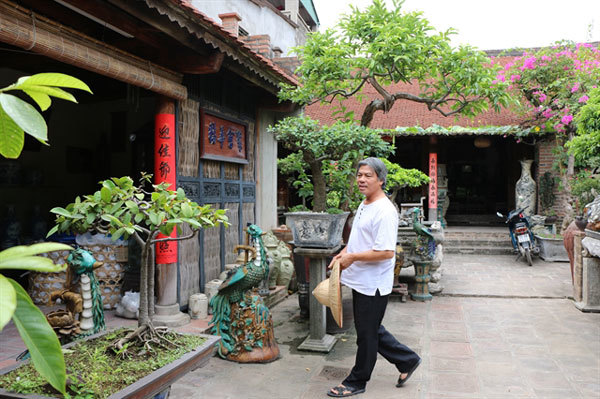 |
| PEACEFUL: An Thuan Duong, the old house with traditional archiecture, owned by artisan To Thanh Son is a popular spot in Bat Trang. |
Hoang Lan Anh from Hai Ba Trung District, Hanoi, often brings her children to Bat Trang to buy decorative objects for their house.
Though she admits she doesn’t know much about the pottery wares, she enjoys the beauty of the countryside and the delicate cuisine.
“We just come to the central market of Bat Trang to visit some big shops, and buy what we need,” she said.
“My children love to make pottery and paint on the ceramic statues.”
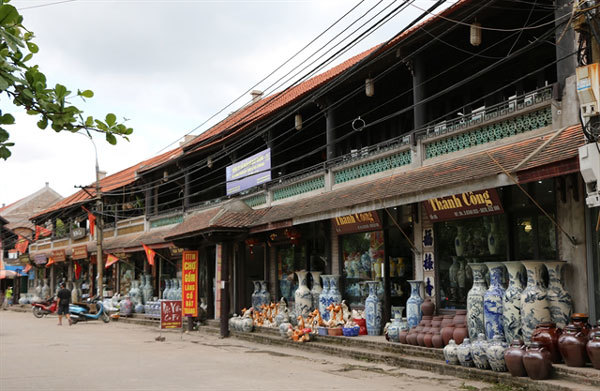 |
| DO IT YOURSELF: The central market allows tourists to buy ceramic items and make pottery at some workshops. VNS Photos Doan Tung |
Now, visitors like Anh have a chance to understand more about the special pottery villages and experience ancient cultural values that still exist today.
There are many places to visit in Bat Trang, old houses like the one owned by artisan To Thanh Son, Tieu Dao Pagoda, Bo Bat old kiln, Kim Truc Pagoda, Giang Cao Temple and Mother Goddesses Temple.
Apart from these relics, the core of Bat Trang Commune is 23 traditional houses, 16 family temples and many old kilns, all built with Bat Trang bricks.
Tourists can enjoy a traditional feast at Hoa Thu Restaurant with artisan Pham Thi Hoa as well as traditional dishes such as spring rolls and bamboo shoots and squid soup at a French-style house with artisan Nguyen Thi Lam and Trang An old house with artisan Pham Thi Dieu Hoai.
Artisan Son says he was happy when his mansion became a stop on the route to discover Bat Trang.
Tourists can see his artworks including a 1.65m high jar that has received much praise from cultural researchers and the public.
The jar is decorated with historical events from the Dinh (10th century) to Ly (1009–1225) dynasties that leads to King Ly Thai To’s decision to move the capital to Thang Long. It is covered with tea-coloured enamel that was polished then burned at 1,270 degrees Celsius.
Son recites an old saying: “I wish I could marry you, I will buy Bat Trang bricks to build our house”. The saying shows Bat Trang bricks were the pride of the north of Vietnam. They are firm, durable, not wet on humid days and not easily stuck to by moss.
“I feel proud to be a resident in the commune, I am happy to receive tourists, sometimes they don’t ask much, just silently drink the green tea and contemplate my house under the green canopy,” Son says.
“The old house is like a museum where the lifestyle of the local people and the aged-old craft are preserved,” he says.
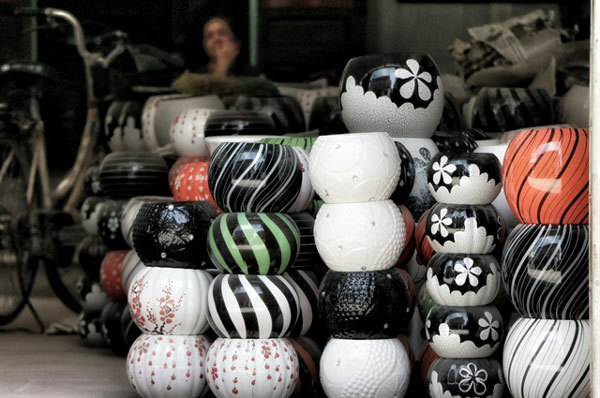 |
| OLD AND NEW: Apart from traditional enamel items, many ceramic wares with modern design are available at Bat Trang Commune. |
The Hanoi Department of Tourism, in collaboration with Gia Lam District People’s Committee, has applied smart tourism to Bat Trang Commune.
In the first phase of the project, the websites dulichbattrang.net and battrangtour.com have been built in Vietnamese and English providing information about Bat Trang. Tourists will find about the way to get there, what to do, what to eat and what to buy. Stories about the destinations and products will be written by Bat Trang residents themselves.
Ly Duy Thanh, vice chairman of Gia Lam District People’s Committee, is very excited to talk about the strategy to develop smart tourism in the commune.
“We have tried to develop tourism in recent years, we have received many tourists actually,” says Thanh.
“But now, the information is brought to tourists in a very amazing and innovative way to lure tourists to Bat Trang and bring wonderful experiences to them,” he says.
A tourist information centre is available now at the entrance to support visitors and provide other services, including an audio tour in 12 languages, free maps, reservation for meals, bicycle hire and virtual reality experiences.
“The local authorities and people are very happy and willing to welcome tourists, we realise clearly the innovation and development of our hometown,” Thanh says.
“Now the streets are cleaner, the kilns don’t spread smoke and dust from burning coal. We use smart devices to support tourists. The whole tourist site is covered with free wifi.”
Thanh acknowledges that wifi is an important factor that helps tourists understand more about the destination and have more interesting experiences.
“In the second phase of the project in 2020, we will use electric cars for transporting towards developing sustainable tourism. More services and tours will be designed to provide various options for tourists.
“We will continue to digitalise the heritage of the site through 3D images,” he adds.
Community-based tourism
There are 200 enterprises and 1,000 households who produce and trade ceramic wares in Bat Trang Commune. The products have been exported to many countries such as Japan, South Korea, Thailand, Russia, Italy, and France.
In recent years, Bat Trang has received 200,000 visitors each year, according to Thanh.
“We acknowledge that the human factor is most important to preserve the traditional trade and develop the local tourism and economy,” he says.
“The artisans with talent and high skill have made sophisticated products that bring good fame for the site. So we are determined that tourism development is based on the community."
“Before launching the strategy of developing smart tourism, the city's department of tourism organised a training course to tell local people and potters the definitions of tourism and craft village tourism,” Thanh says.
“They show awareness of preserving the trade, upgrading the product quality and how to introduce tourists about the heritage.”
“Being involved in local life and learning to make pottery with skilled workers is attractive to tourists. That’s why local people play an important role. They are owners of the heritage.”
Nguyen Thu Thuy, PhD, lecturer at the Tourism Faculty of the University of Social Sciences and Humanities, says community-based tourism is the current trend of the world tourism industry.
“When travellers have a chance to visit the production chain, talk to the artisans and learn how the products are made, they will believe in the products’ quality,” she says.
“Tourists love the truthfulness of the destination, they love to discover the traditional culture and lifestyle of the local people.
“The local people should be trained to introduce the original values to their guests. When they have professional skill and basic knowledge of tourism, they will be the best tour guides.”
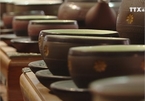
Bat Trang in the spotlight of Hanoi craft village tourism
Besides Van Phuc silk village, Bat Trang pottery village in Gia Lam, Hanoi has been designated to become one of signature destinations of the capital city’s trade village tourism development plan.
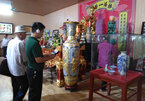
Centuries-old village turns to smart tourism
As part of a new initiative, smart tourism will be applied at the centuries-old Bat Trang Commune. Now, old kilns, ancient houses and pottery workshops will be ready to receive a new wave of tourists.

Bat Trang pottery village
The over five-century old Bat Trang pottery village is situated on the bank of the Red River.
By Minh Thu
VNS
 In the mornings before he opens his traditional house to visitors, Meritorious Artist To Thanh Son prepares tea to welcome his guests.
In the mornings before he opens his traditional house to visitors, Meritorious Artist To Thanh Son prepares tea to welcome his guests.